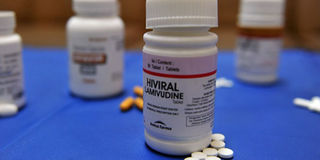Kenya warned on HIV donor funding

Pills of antiretroviral (ARV) medicine on display. Kenya’s successful campaign against HIV prevalence could be affected by over-reliance on donor. PHOTO/AFP
What you need to know:
- Over 80 per cent of Kenya’s HIV programmes externally funded
- The largest donors are the US President’s Emergency Plan for AIDS Relief and the Global Fund to fight AIDS, Tuberculosis and Malaria
Kenya’s successful campaign against HIV prevalence, which saw infections drop from 7.2 per cent to 5.6 per cent in five years, could be adversely affected due to over-reliance on donor funding
The United Nations Office for Co-ordination on Humanitarian Affairs called on the government to allocate funding for provision of Anti-retroviral (ARV)drugs as well as ongoing programmes to train
Kenyans on effective ways to protect themselves.
National AIDS and Sexually Transmitted Infections Control Programme’s (NASCOP) Head of Prevention, Mr Peter Cherutich warned that over 80 per cent of Kenya’s HIV programmes are externally funded thus unsustainable.
The largest donors are the US President’s Emergency Plan for AIDS Relief and the Global Fund to fight AIDS, Tuberculosis and Malaria.
“In the event that they stop funding such programmes, these interventions could stall and thus draw back the gains that have so far been realised,” he said.
He added that another key priority for the government was to get more people to know their HIV status so as to get more people on treatment and reduce the number of new infections.
In a dispatch to IRIN website, Mr Cherutich said HIV prevalence was falling with HIV-positive people living longer as a result of the donor funded free ARV treatment.
“We attribute the fall in prevalence mainly to fewer new infections, which are a result of putting more people on treatment,” he added.
ARV TREATMENT
Earlier ARV treatment can reduce the risk of heterosexual HIV transmission by as much as 96 per cent, says a recent study commissioned by NASCOP.
The ARV programme managed through public hospitals has ensured that more than 70 per cent of eligible HIV-positive Kenyans - those with a CD4 count (a measure of immune strength) of 350 or lower - are on ARVs which has successfully shown an effective “viral suppression” to undetectable levels.
The country also has a number of HIV-prevention interventions - from prevention of mother-to-child transmission programmes to medical male circumcision and counselling and testing campaigns - that have contributed to lower infections and higher rates of treatment.
The beneficiaries of the ARV programme have a low risk of infecting others with the virus in a country where close to 1.2 million Kenyans are living with HIV. Women have an overall prevalence of 6.9 percent, compared to men’s prevalence of 4.4 per cent and children’s 0.9 per cent prevalence.





